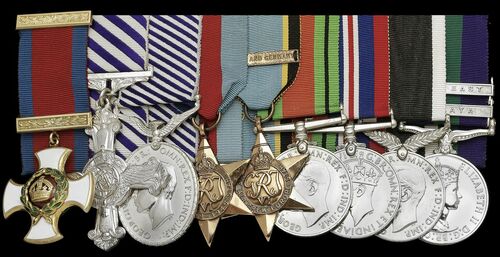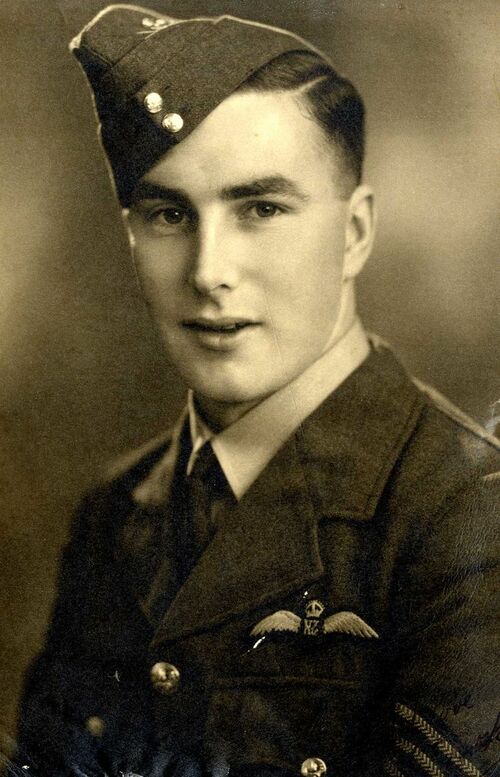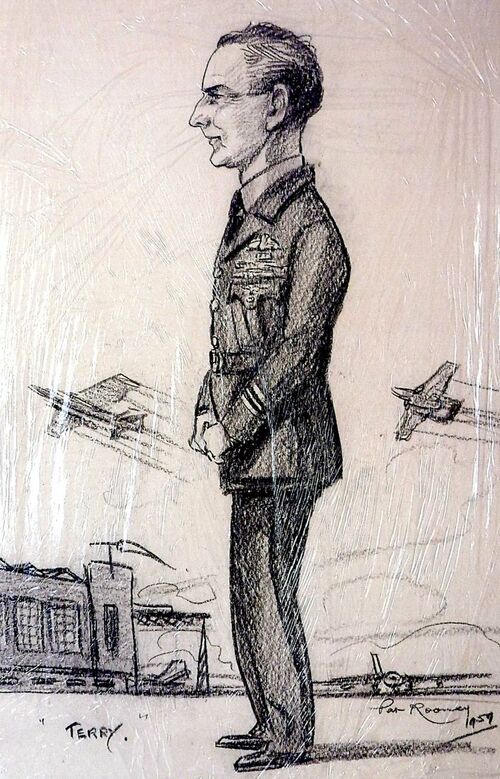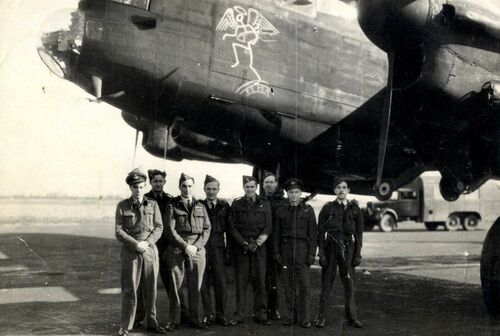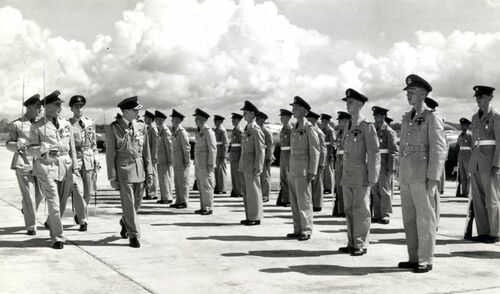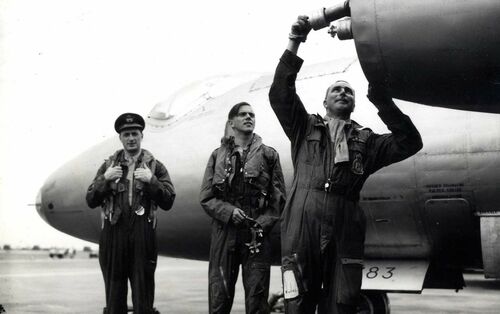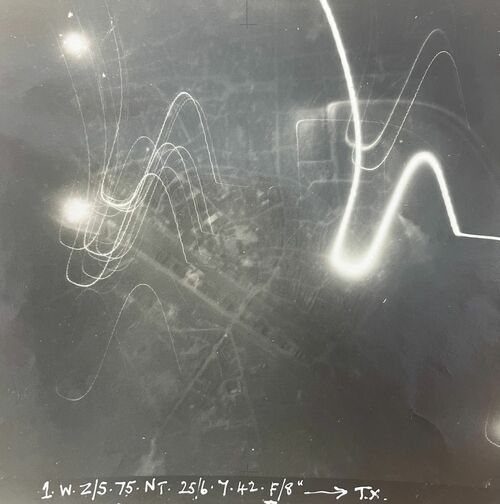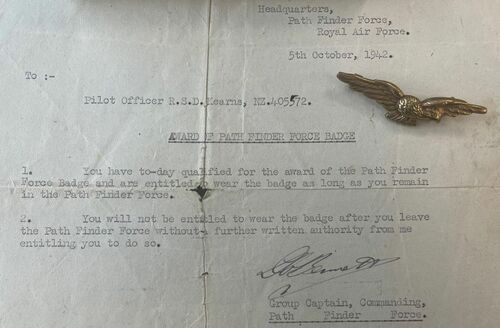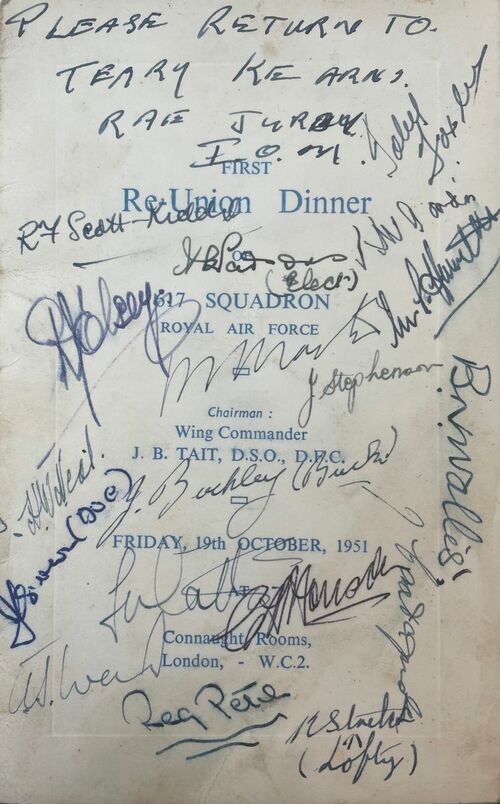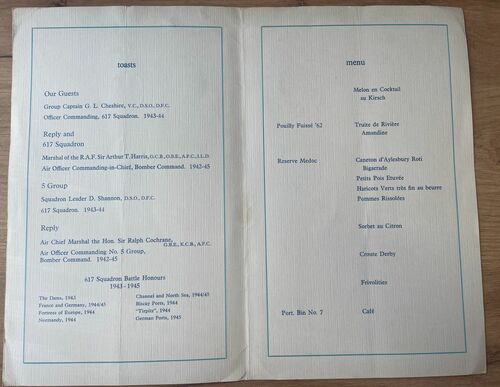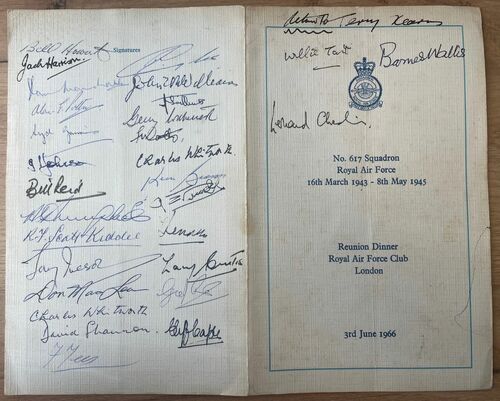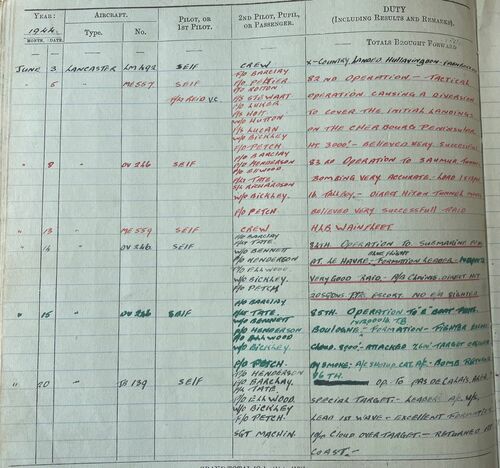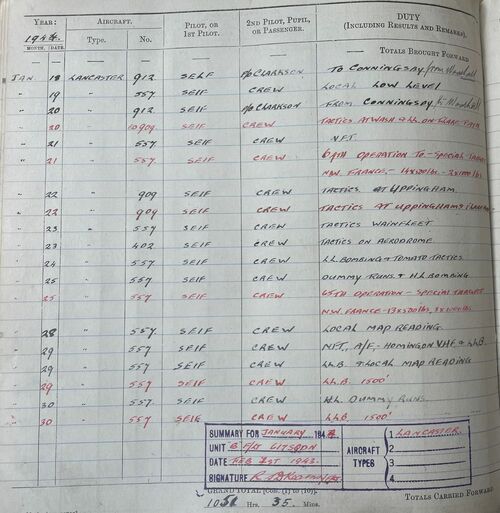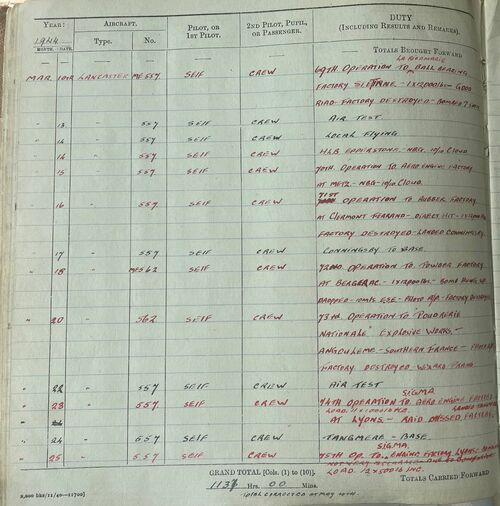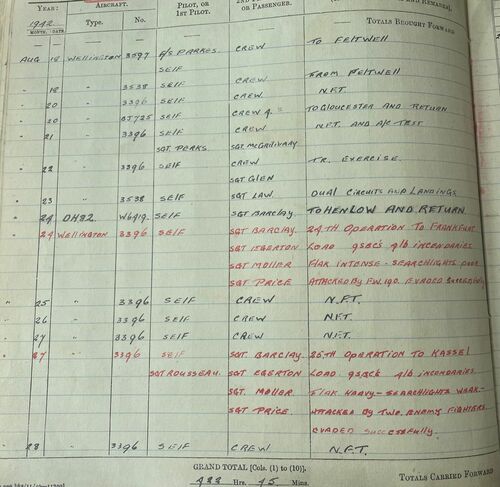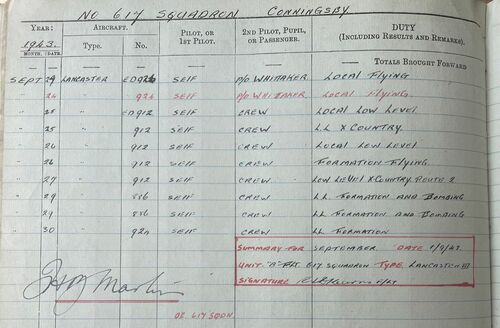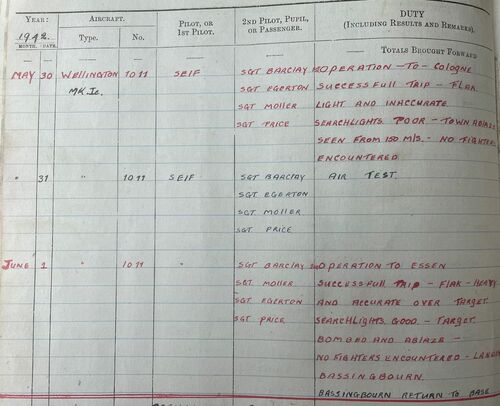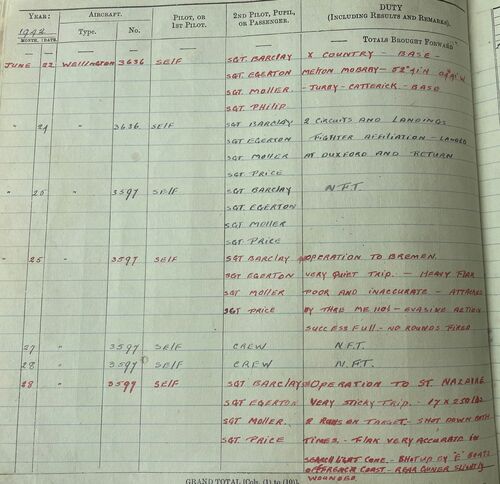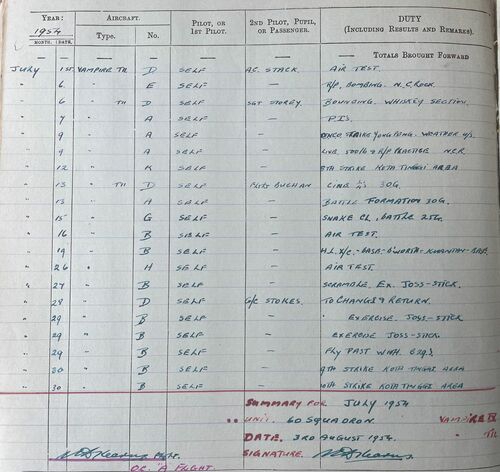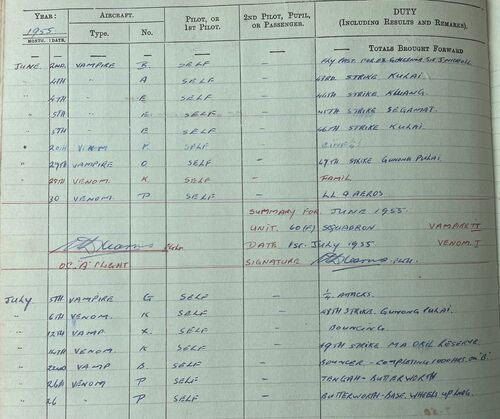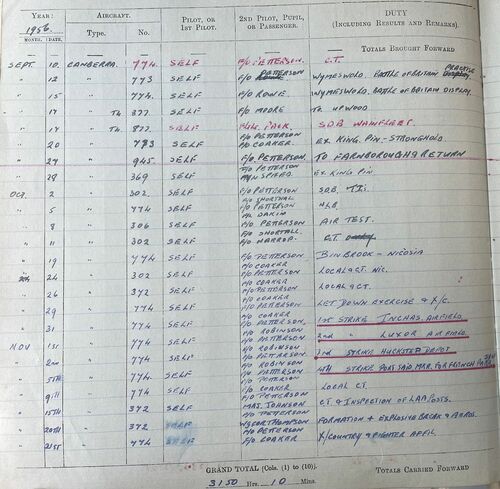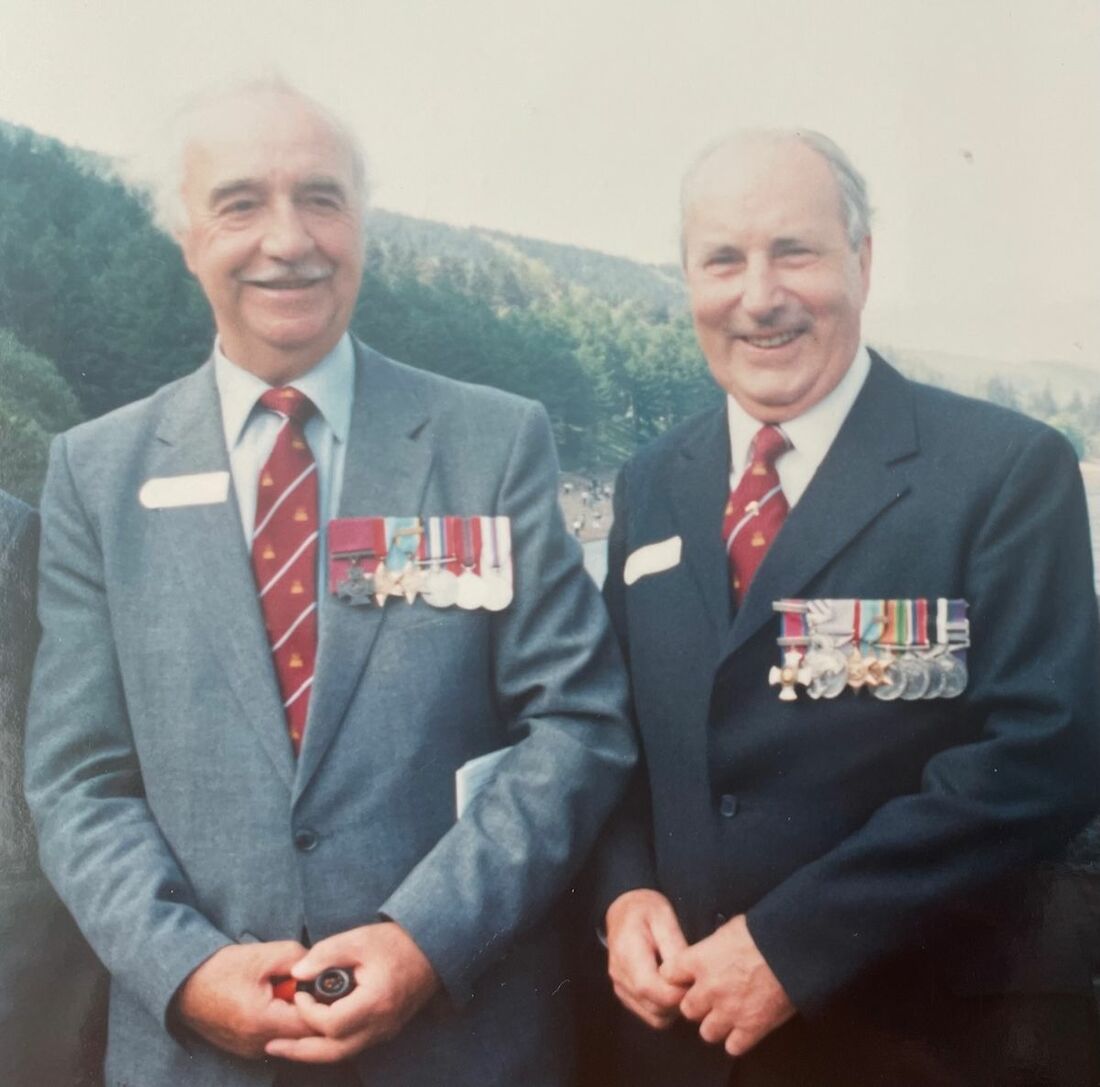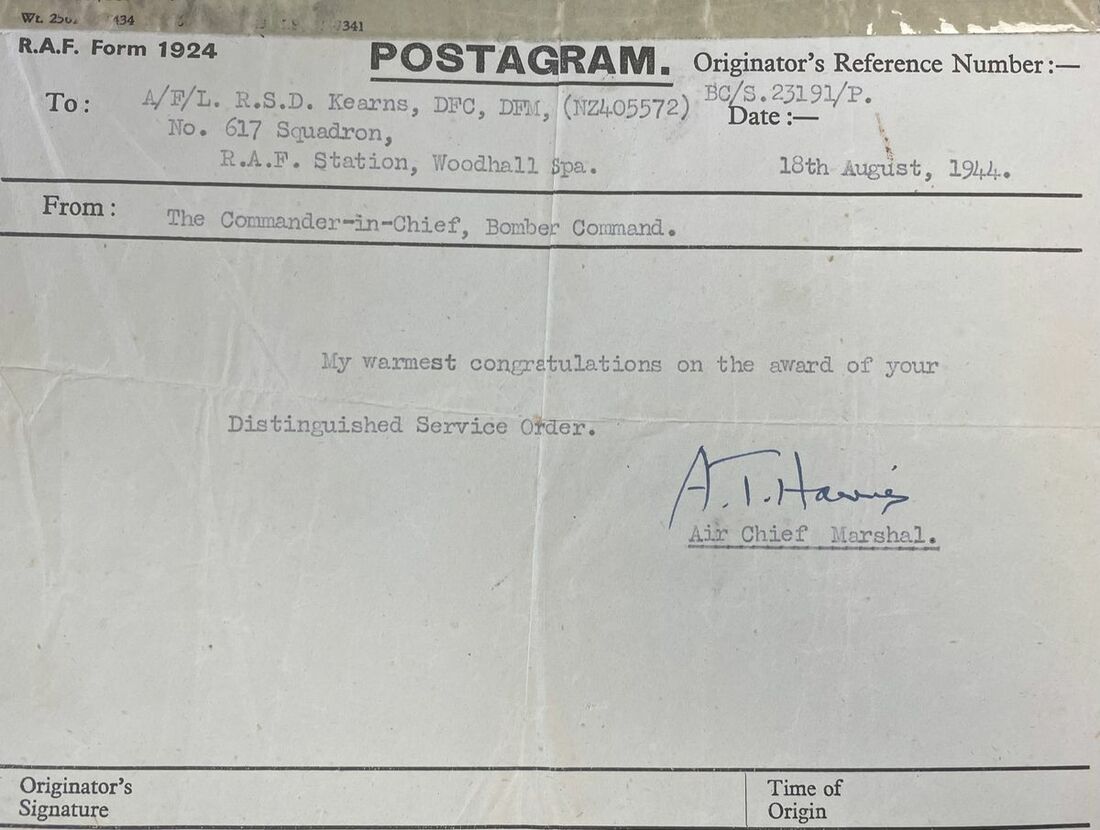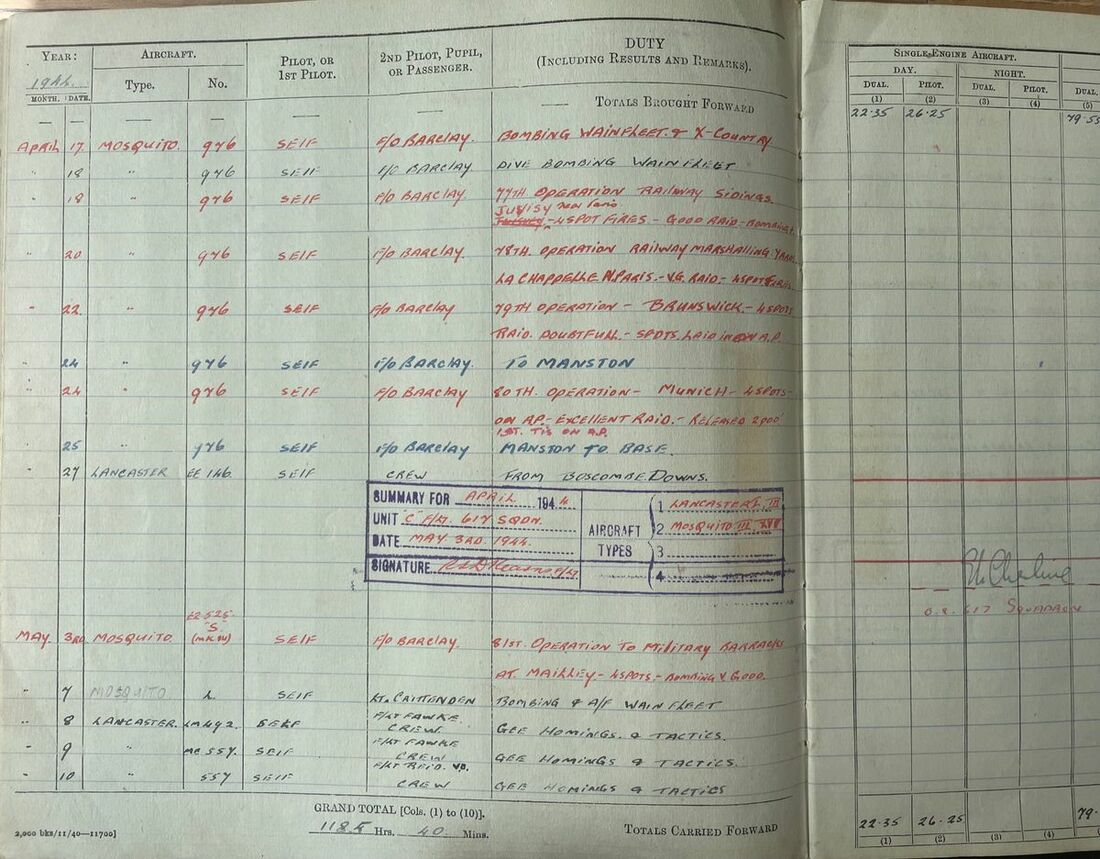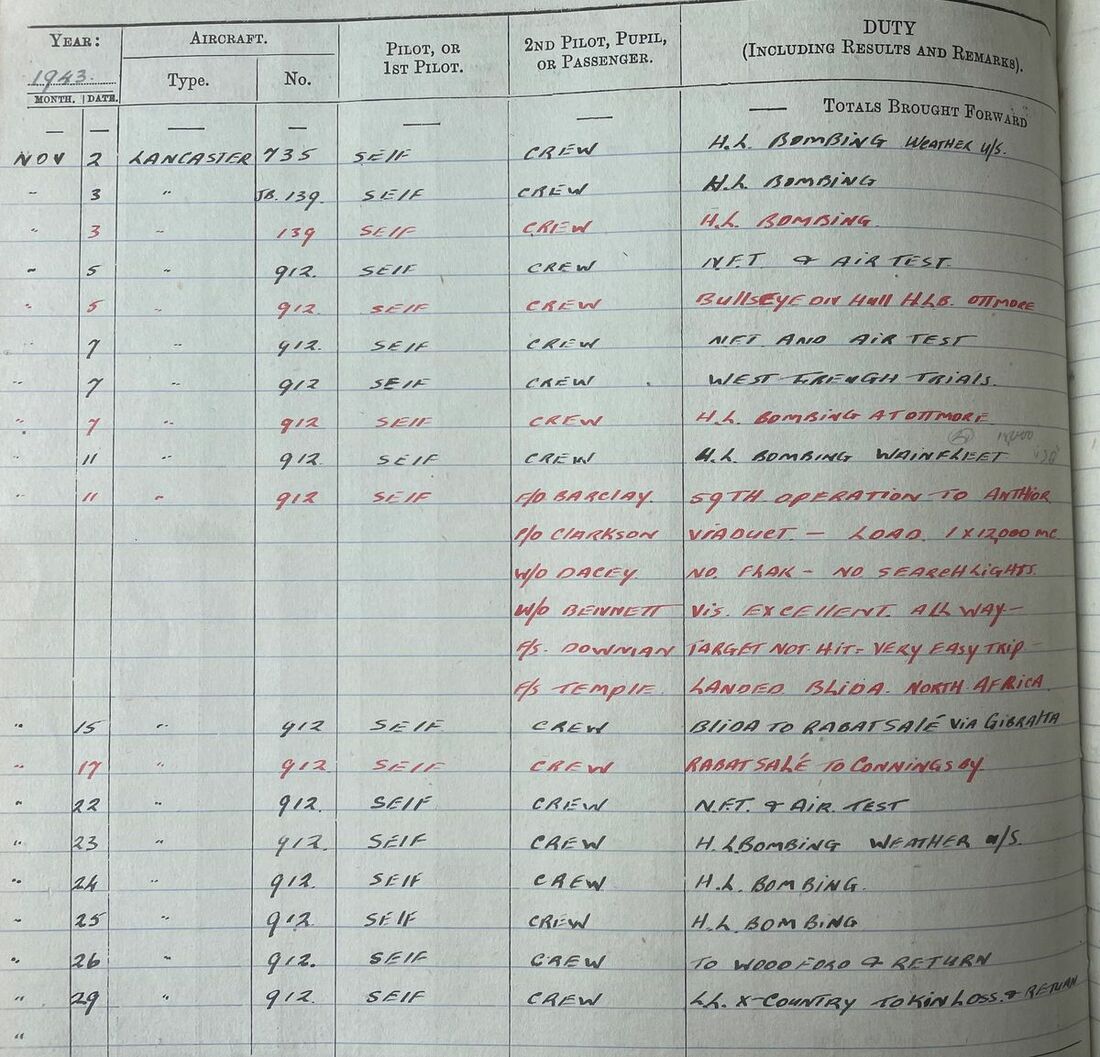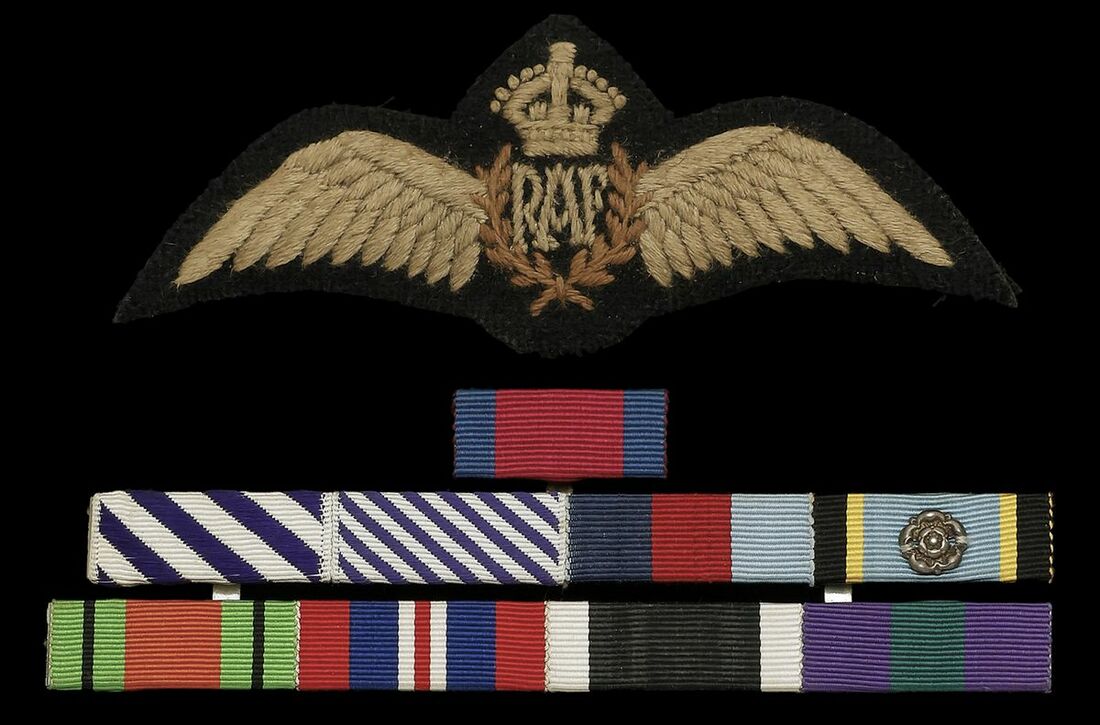Auction: 23003 - Orders, Decorations and Medals
Lot: 312
The outstanding Second World War No. 617 (Dambuster) Squadron 'Special Duties' 1944 D.S.O., 1943 'Pathfinder's' D.F.C., 1943 D.F.M. group of nine awarded to Wellington, Lancaster and Mosquito Pilot, Squadron Leader R. S. D. 'Terry' Kearns, Royal New Zealand Air Force
A veteran of at least 87 Ops, he flew 30 of them with the famous "Dam Busters"; Kearns shared in the first 'Thousand-Bomber Raids' and became a "Tallboy" specialist
Arguably his finest hour came when he scored a direct hit, with the "Earthquake" Bomb, on the entrance of the Saumur Tunnel on 8 June 1944; having obliterated Leonard Cheshire's marking Flare he caused the Squadron Commander to remark "...hold on chaps, I'll have to mark it again."
After a brief flirtation with Vampire Jets over the Malayan Jungle - in which he flew on nearly 50 'strikes' - Kearns returned to Bomber Command to take part in Operations during the Suez Crisis in November 1956
Distinguished Service Order, G.VI.R., silver-gilt and enamel, reverse of suspension bar officially dated '1944', with integral top-riband bar, this adapted for mounting; Distinguished Flying Cross, G.VI.R., reverse officially dated '1943'; Distinguished Flying Medal, G.VI.R. (NZ. 405572 Sgt. R.S.D. Kearns. R.N.Z.A.F.), suspension a little slack; 1939-45 Star; Air Crew Europe Star, clasp, France and Germany; Defence and War Medals 1939-45; New Zealand War Service Medal 1939-45; General Service 1918-62, 2 clasps, Malaya, Near East (Flt. Lt. R.S.D. Kearns. R.A.F.), mounted court-style for wear, light contact marks throughout, very fine (9)
Just 2 combinations of D.S.O., D.F.C., D.F.M. awarded to the Royal New Zealand Air Force for the Second World War.
D.S.O. London Gazette 26 September 1944. The original Recommendation states:
'Flight Lieutenant Kearns has now completed a total of 87 operational sorties as captain of aircraft, 39 of which have been undertaken since he was awarded the D.F.C. in March, 1943. He has, moreover, frequently operated against the most heavily defended objectives in Germany and has on many occasions returned to base with his aircraft damaged through enemy action. During the last seven months he has been employed on Special Duties and a particularly high standard of leadership and skill has been essential for the successful completion of the independent and often hazardous operations of his Squadron. This officer has never failed to rise magnificently to the occasion and he has truly set an outstanding example of fortitude and determination. He has consistently brought back aiming-point photographs and he has never once failed to complete his task.
The unsurpassed gallantry and devotion to duty which this officer has so long and so enthusiastically displayed has had a most profound effect upon the morale and fighting spirit of his Squadron. His cheerfulness, great courage, and determination have enabled him to create a crew whose efficiency could not be exceeded in the Royal Air Force of today. His efforts have resulted in much damage to the enemy and his conduct and leadership throughout his operational career have been an inspiration to all and are worthy of the highest praise.'
Remarks by Base Commander: 'During his long tour of operational duty, Flight Lieutenant Kearns has shown exceptional determination and courage. He proved himself one of the best Captains in the Squadron and he set an example which was admired by all his associates.'
D.F.C. London Gazette 20 April 1943. The Recommendation states:
'This officer has carried out 46 operational flights over enemy and enemy occupied territory. During the time he has been with this squadron, he has completed 19 operational sorties against targets in Germany, Italy and enemy occupied territory. Flight Lieutenant Kearns has been consistent in pressing home his attacks, and has at all times displayed the highest qualities as a pilot, and it has been largely due to his sense of airmanship that his many operations have been successfully performed. By his capabilities as a pilot, and supreme devotion to duty, he has set a very high example to the other members of the squadron.'
D.F.M. London Gazette 27 October 1942. The original Recommendation states:
'The above named N.C.O. has completed 22 major operations and in each and every case has displayed determination of a very high order. He expends every effort to find and bomb the target and to date he has been most successful, bringing back a photograph of the aiming point when many other crews have been unsuccessful in their mission. He sets a fine example to all aircrew of high devotion to duty and cool courage in the face of intense opposition.'
Covering Remarks of Station Commander:
'An outstanding operational pilot whose courage, keeness, enthusiasm and devotion to duty deserve the highest recognition. Through an intensive operational period this pilot maintained these qualities up to an exceptional level.'
Richard Stansfield Derek Kearns - or 'Terry' to his friends and comrades - was born at Reefton, New Zealand on 9 March 1920 and studied Engineering at Canterbury College. He joined the Royal New Zealand Air Force in December 1940 and carried out Pilot training at No. 1 E.F.T.S Taieri and No. 1 F.T.S. Wigram, gaining his 'Wings' on 26 July 1941. Arriving in England in November 1941, Kearns undertook a refresher course at No. 1 A.F.U., R.A.F. College Cranwell and was posted to No. 11 O.T.U., Bassingbourn, for conversion to Wellingtons in March 1942. Whilst at Bassingbourn Kearns formed his crew of:
Navigator W.J. 'Hone' Barclay, Wireless Operator M.W. Egerton, and the two Gunners J.A. Moller and H.E.A. Price; this crew were to carry out two tours of operations together, with Kearns and Barclay flying together for most of the Second World War.
Whilst stationed at No. 23 O.T.U. he flew on the first 'Thousand Bomber' raid to Cologne on 30 May 1942. That fateful night some 1,047 aircraft dispatched in 'Operation Millennium' in the first use of the 'bomber stream' to overwhelm enemy radar and defences by flying in a narrow dense formation. Bomber Command recorded 868 bombers attacking the target with 1,455 tons of bombs. Over three thousand buildings were destroyed and another nine thousand damaged.
He quickly followed this up by sharing in the second 'Thousand Bomber' raid on Essen on 1 June1942. Posted for operational flying to No. 75 (New Zealand) Squadron (Wellingtons) at Feltwell, Norfolk, Kearns and his crew carried out their Tour of 25 Ops which included raids on:
Emden; Bremen (3), including on 25 June 1942, 'Attacked by Three ME 110s - Evasive Action Successful'; St. Nazaire, 28 June1942, 'Very Sticky Trip - 17 x 250lbs. 2 Runs on Target - Shot Down Both Times - Flak Very Accurate in Search Light Cone - Shot Up By "E" Boats Off French Coast - Rear Gunner Slightly Wounded'; Frisian Islands (2); Wilhemshaven; Duisberg (4); Hamburg (2), including 26 July 1942, 'Load 9 S.B.C.s - Very Busy Trip - Bombs in Target Area - Brought to OFT By Flak and Searchlights & 7 Searchlights Destroyed and One Machine Gun Nest Silenced - Good Trip'; Saarbrucken (2), including 29 July 1942, 'Load 1 x 1000lb, 7 x 500lb, 2 x 250lb. Bombs in Target - No Searchlights - Flak Weak - One Ju 88 Encountered - Close Call'; Dusseldorf; Essen; Osnabruck (2); Mainz (2); Frankfurt, 24 August 1942, 'Load 9 S.B.C.s 9lb Incendaries. Flak Intense - Searchlights Poor. Attacked By F.W. 190 Evaded Successfully'; Kassel, 27 August 1942, 'Attacked By Two Enemy Fighters. Evaded Successfully'; and Nurnburg.
Details of his trip to Hamburg on 26 July is recalled in Night After Night by Max Lambert:
'The Kearns team flew both Hamburg raids, their 14th and 15th ops. Moller, a youthful 19, had the time of his life the first night, Their Wellington – in the first wave with a load of incendiaries for starting fires to light up the target for the follow-up bombers – was coned by searchlights over the city. Kearns dived steeply, down to rooftop level, before flattening out. At one stage they were so low they roared under high tension cables strung below pylons. Moller laughs as he remembers. “As we went under, Terry lifted the nose so the big tail would drop and not snag the cables. We got through OK.”
As they flew off, Moller and Price fought an exciting and exhilarating private battle with searchlight crews. The Germans depressed their lights, looking for the cheeky bomber they could hear but not see. Whenever they got a chance – and there were plenty because the city was studded with belts of lights – the gunners turned their barrels down the beams and clattered off hundreds of rounds. Says Moller:
“When we hit them, the lights exploded with a brilliant flash of whites and pinks and went out. The ones I missed, Buck got from the rear turret. I think we shared seven lights between us that night. It was very satisfying. We were young and shouted out when the lights blew up. We were like kids who do wheelies today. Something in our systems we had to get rid of”.
Moller and his mates exulted again when they knocked out a machine gun post firing at them from alongside a searchlight. Moller took aim and cut down a German who jumped out of the gun pit and dashed across the paddock: “I gave him a burst and bowled him over.”'
Kearns was duly transferred to No. 156 (Pathfinder Force) Squadron (Wellingtons and later Lancasters) at Warboys in September 1942. Pathfinder Force had been formed in August 1942 and No. 156 Squadron was one of the four Squadrons to form the nucleus of the new force. Kearns flew in 31 Ops with the Squadron including:
Bremen; Wilhelmshaven (2), including 19 February 1943, 'Load 1 x 1000lb M.C. - 4 X 250 T.I. Bombs - 6 x 500lbs H.E.T. - Vis. Good - Hit By Flak Over Target - Returned on 3 Motors - E A/C Encountered Over A. - A. Photos. Very Interesting Trip - W/Op's Final Op.'; Essen (4); Saarbrucken; Krefeld; Genoa; Hamburg (2); Turin (3); Stuttgart; Mannheim; Duisburg; Munich (2); Lorient (2); Dusseldorf; Cologne; St. Nazaire (2); Berlin; Keil; La Spezia; and Pilsen (raid on Skoda Armaments Factory), 16 April 1943.
617 'Dam Buster' Squadron
Once Kearns had finished his second Tour, he reflected:
'I completed a Flying Instructor Course and was posted back to No.11 O.T.U. now located at R.A.F. Westcott. I was an Instructor on the satellite airfield - R.A.F. Oakley - converting pilots to Wellington Aircraft before they joined the remainder of their crew at R.A.F. Westcott for advanced training. I was recalled to Operational Flying with No. 5 Group in September 1943. My Navigator Flight Lieutenant Barclay and I joined [C Flight] No. 617 Squadron as it moved to R.A.F. Conningsby. We formed a new crew and trained to the operational requirements in Low Level Flying and Specialist attack procedures. In addition when the Stabilised Automatic Bomb Sight (SABS) was introduced, we trained for the delivery of the 12,000lb Blast Bomb. This was replaced by the 12,000lb Tallboy and later by Grand Slam (22,000lb). Our best effort on the practice range was - I believe - never beaten. The average error of eight practice bombs dropped from 20,000ft on Wainfleet Bombing Range was 15 yards from the Aiming Point Peg.'
Due to the casualties suffered by 617 Squadron during the Dams Raid, May 1943, Kearns was one of several new Skippers drafted in to bolster their strength:
'...it was a new squadron being formed for a special low level operation on an unknown target - all very Hush Hush. He [Len Chambers] passed my name on to the C.O. Guy Gibson - as a recruit - but I could not get my release from instructing at Westcott/Oakley until after the Dams Raid.'
Thus he flew his first Op with the Squadron, now led by Leonard Cheshire, to the Antheor Viaduct on 11 November 1943. It would be the first of a remarkable 30 Ops flown by him with No. 617 Squadron, including to 7 Special Duties Targets over December 1943-January 1944 - a series of pin-point attacks against factories in France which were reluctantly working for the German war effort, where the object was ensure maximum damage with minimum loss of French lives. Other operations included:
the Gnome & Rhone Aero-Engine Factory, Limoges, 9 February 1944, when Cheshire tried out his newly developed low-level marking system for the first time on operations; Aircraft Factory at Albert, 2 March 1944; La Ricamerie, 10 March 1944 'To Ball Bearing Factory St. Ettienne - 1 x 12,000lbs - Good Raid - Factory Destroyed - Bombed 7,500 feet'; Aero-Engine Factory, Metz, 15 March 1944; Michelin Tyre Factory, Clermont-Ferrand, 16 March 1944, 'Direct Hit - 1 x 12,000lb. Factory Destroyed - Landed Conningsby'; Powder Factory, Bergerac, 18 March 1944; Explosive Works, Angouleme, 20 March 1944, "Pouderie Nationale" Explosive Works - Angouleme - Southern France. Photo A/P Factory Destroyed - Wizard Prang'; Aero-Engine Factory, Lyons (3); he converted to Mosquitos and returned to fly, as one of the Squadron's four Mosquito markers, on operations over Juvisy Railway Sidings, 18 April 1944; Railway Marshalling Yards, La Chappelle, North of Paris, 20 April 1944; Brunswick, 22 April 1944 - the first time the Squadron used its low-level marking method over a heavily defended German city; Munich, 24 April 1944; German Military Barracks, Mailly-Le-Camp, 3 May 1944.
Returning to Lancasters he flew in Operation Taxable, 5/6 June 1944, as part of the D-Day landings, 'Tactical Operation Causing a Diversion to Cover the Initial Landings on the Cherbourg Peninsular. Ht. 3000! - Believed Very Successful.'
Two days later he flew in the attack led by Cheshire on the Saumur Railway Tunnel, this was the first occasion that Barnes Wallis' new 12,000lb Tallboy bombs were used and Kearns used it to very good effect, 'Bombing Very Accurate - Load 1 x 12,000lb Tallboy - Direct Hit Tunnel Mouth. Believed Very Successful Raid.' A newspaper cutting adds the following detail 'Kearns...scored a bull's eye with his "Tallboy" - a 12,000lb earthquake bomb. He was so accurate that he obliterated the Squadron Commander Leonard Cheshire's marking flare, preventing other Lancaster crews from seeing their target. "Hold on chaps," Cheshire said. "I'll have to mark it again"'
The operation was a complete success, the tunnel was destroyed, and a German Panzer division was prevented from reaching the Allied invasion beach-head that had been established two days earlier. Four days later Kearns was part of the operation over the Submarine Pens at Le Havre, 'Blue Flight Formation Leader - 1 x 12,000T.B. Very Good Raid - A/B Claims Direct Hit', the next day he attacked, with the same bomb load, the "E" Boat Pens at Boulogne; he flew two abortive sorties on a V-Weapon site at Wizernes, Pas De Calais, before carrying out his final operational sortie of the Second World War on 25 June 1944:
'Operation to "Siracourt" Rocket Installation - 3 Direct Hits On Installation - Flak Damage - Cat A/C. Load 1 x 12,000lb T.B.'
Posted as Chief Flying Instructor to No. 17 O.T.U., Silverstone, October 1944, towards the end of the Second World War he was seconded to British Overseas Airways Corporation to fly transports on the Karachi route and on 28 May 1946 he piloted the '1st BOAC Service Out of London Airport'. On 8 June1946, he helped fly a Sunderland in the '"V" Day Fly Past In London' and was finally discharged in 1947.
Returning to his native New Zealand to complete his studies, he accept a permanent commission in the Royal Air Force in 1949. Posted to No. 3 (T) Squadron at the start of 1949, he spent the following two years at No. 1. I.T.S., flying a mixture of aircraft including Vampires and Meteors. Posted for operational service in Malaya to No. 60 (Fighter) Squadron (Vampires) at Tengah from December 1952, he carried out numerous 'strikes', rocket attacks and jungle reconnaissance as "A" Flight Commander (Medal & clasp). Having spent two years at Tengah he was posted back to the United Kingdom in April 1954. Returned to Tengah that summer, he continued to serve with the Squadron over the Malayan jungle until the end of July 1955, by that time having taken part in 49 operational "strikes".
Once again returned to Bomber Command, Kearns was posted to R.A.F. Lindholm, followed by No. 231 O.C.U., Bassingbourn, where he converted to Canberras. Being advanced Squadron Leader in 1956, he was posted as Flight Commander to No. 139 (Jamaica) Squadron (Canberras), Binbrook, January 1956. The Squadron took part in the Suez Crisis, and flying from Nicosia, Kearns' shared in the following:
31 October 1956, '1st Strike Inchas Airfield'
1 November 1956, '2nd Strike Luxor Airfield'
2 November 1956, '3rd Strike Huckster Depot'
5 November 1956, '4th Strike Port Said, Mkr. For French Para Drop'
Having duly added a second clasp to his G.S.M., Kearns was posted to H.Q. Bomber Command Communications Squadron (Meteor Flight) in April 1959. He subsequently held a number of appointments including as part of the operational control of the Thor Missile Programme. In 1963 he contracted tuberculosis and was forced to retire later that year. Never one to live life in the slow lane, he took up work for Shell, before retiring in 1980. Kearns spent his retirement well, indulging in his passion for trout and salmon fishing (of which the cataloguer is highly approving).
Sold together with the following original archive comprising:
(i)
Pathfinder Force Badge with two Enclosures relating to the award of the Badge and his riband bar.
(ii)
Bestowal Document for the Distinguished Service Order, dated 26 September 1944.
(iii)
Two R.N.Z.A.F. Pilot's Flying Log Books, covering the period 5 May 1941-30 June 1946 and 15 July 1946-23 May 1960), the first signed by Leonard Cheshire in his capacity as Commanding Officer No. 617 Squadron.
(iv)
Civil Pilot's Log Book and Pilot's Certificate and Licence For Public Transport or Aerial Work Flying Machines, whilst employed by British Overseas Airways Corporation.
(v)
Congratulatory Postagram for the award of the D.S.O. from Air Chief Marshal A.T. 'Bomber' Harris, dated 18 August 1944.
(vi)
Air Ministry Letter to recipient on the occasion of his retirement from the Service, dated 7 March 1963
(vii)
Two Audio CDs with recordings of interviews carried out with recipient relating to his war memories.
(viii)
A number of photographs relating to various stages of recipient's career.
(ix)
First Reunion Dinner of No. 617 Squadron Menu, dated 19 October 1951, with a large number of signatures including: Barnes Wallis and Jack Buckley.
(x)
A No. 617 Squadron Reunion Dinner Menu, dated 3 June 1966, with a large number of signatures including: Leonard Cheshire, Barnes Wallis, Bill Reid, David Shannon, and Don Maclean, together with other related items.
His memories of his career were captured by the Imperial War Museum in 1986, the recording totalling some 130 minutes. They are available via:
www.iwm.org.uk/collections/item/object/80009092
Subject to 20% VAT on Buyer’s Premium. For more information please view Terms and Conditions for Buyers.
Estimate
£28,000 to £32,000
Starting price
£20000

